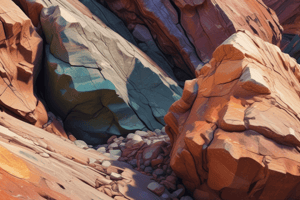Podcast
Questions and Answers
Which rock is formed through the metamorphosis of coal?
Which rock is formed through the metamorphosis of coal?
- Slate
- Gneiss
- Shale
- Anthracite (correct)
What metamorphic rock is characterized by its sheen and larger platy minerals?
What metamorphic rock is characterized by its sheen and larger platy minerals?
- Phyllite (correct)
- Schist
- Slate
- Quartzite
What type of metamorphism occurs primarily due to the intrusion of magma?
What type of metamorphism occurs primarily due to the intrusion of magma?
- Burial Metamorphism
- Regional Metamorphism
- Shock Metamorphism
- Contact Metamorphism (correct)
Which metamorphic rock displays banding of minerals?
Which metamorphic rock displays banding of minerals?
What is the primary characteristic of non-foliated metamorphic rocks?
What is the primary characteristic of non-foliated metamorphic rocks?
Which of the following is an index mineral that forms under specific temperature and pressure conditions?
Which of the following is an index mineral that forms under specific temperature and pressure conditions?
What defines regional metamorphism?
What defines regional metamorphism?
What is the defining feature of schist?
What is the defining feature of schist?
What type of metamorphism is characterized by high heat and pressure due to flux melting?
What type of metamorphism is characterized by high heat and pressure due to flux melting?
Which rock transforms into marble through metamorphism?
Which rock transforms into marble through metamorphism?
Flashcards
Metamorphic Rocks
Metamorphic Rocks
Rocks that have been altered by heat, pressure, or fluids.
Burial Metamorphism
Burial Metamorphism
A type of metamorphism where rocks are deeply buried, experiencing high heat and pressure.
Contact Metamorphism
Contact Metamorphism
A type of metamorphism that occurs when magma comes into contact with cooler rocks, primarily changing them through heat.
Regional Metamorphism
Regional Metamorphism
Signup and view all the flashcards
Subduction Zone Metamorphism
Subduction Zone Metamorphism
Signup and view all the flashcards
Shocked Metamorphism
Shocked Metamorphism
Signup and view all the flashcards
Foliated
Foliated
Signup and view all the flashcards
Lineated
Lineated
Signup and view all the flashcards
Non-Foliated
Non-Foliated
Signup and view all the flashcards
Metamorphic Grade
Metamorphic Grade
Signup and view all the flashcards
Study Notes
Metamorphic Rock Formation
- Metamorphic rocks are formed from existing rocks (igneous, sedimentary, or other metamorphic rocks) through changes in temperature, pressure, or fluids.
- Metamorphism involves alteration without melting.
- Metamorphic grade indicates the extent of change a rock has undergone. Index minerals (minerals forming under specific conditions) help define metamorphic grade.
- Directed stress refers to unequal forces acting on rocks in one or more directions. Confining pressure is equal pressure applied from all sides. Strain are the results of stress on a rock.
Types of Metamorphism
- Burial Metamorphism: Deep burial causes heat and pressure, often creating foliated rocks.
- Contact Metamorphism: Magma intruding into cooler rocks creates a change mainly through heat. Lower pressure compared to regional metamorphism.
- Regional Metamorphism: Continental plate collisions generate high pressure leading to metamorphism.
- Subduction Zone Metamorphism: Specific regional metamorphism, high heat and pressure caused by flux melting and subduction. More extreme conditions than regional metamorphism.
- Shocked Metamorphism: Meteor impacts cause subtle metamorphic changes in rocks, producing features like shocked quartzite.
Metamorphic Rock Types and Characteristics
- Foliated Rocks: Minerals are aligned in sheets (like pages in a book).
- Lineated Rocks: Minerals arranged in lines (but no sheet formation).
- Non-Foliated Rocks: Minerals have no arrangement.
- Slate: Exhibits slaty cleavage (flat minerals).
- Phyllite: Larger platy minerals with a sheen from light reflection.
- Schist: Visible large, platy grains (individual crystals).
- Gneiss: Displays visible silicate mineral bands (light and dark).
- Quartzite: Formed from sandstone, extremely hard.
- Marble: Formed from limestone, valued for aesthetic properties.
Studying That Suits You
Use AI to generate personalized quizzes and flashcards to suit your learning preferences.




